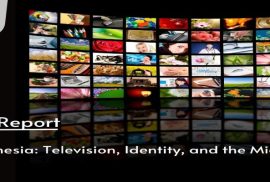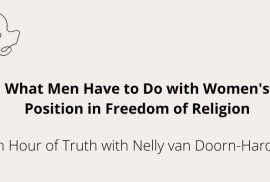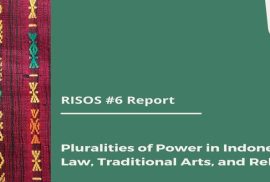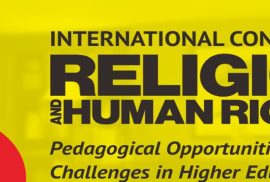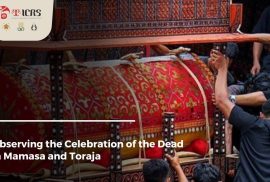Written by Jekonia Tarigan
In the discourse on indigenous religions in Indonesia, two issues that are often discussed are recognition and the wealth of wisdom and culture held by these indigenous religious groups. Meanwhile, the role of adherents of indigenous religion in various aspects of state life seems to be forgotten. Yet, these groups played an important role in the independence struggle and the strengthening of national values. This was the focus of an online forum held on Thursday, 11 August 2022 and organized by the Indonesian Consortium for Religious Studies (ICRS), the Center for Religious and Cross-cultural Studies (CRCS), and the National Commission on Violence Against Women (Komnas Perempuan).
On this occasion, the first speaker was Ratna Gumilang Dumiasih who represented the Sunda Wiwitan group, from West Java. In his presentation, Dumiasih referred to the story of the physical struggle of a Sundanese ancestral religious figure in fighting for Indonesian independence, namely Prince Madrais. Dumiasih explained that in 1869 Prince Madrais was involved in the rebellion against the Dutch in Tambun, Bekasi, West Java. He is called Rama Prince Alibassa of Cirebon. At that time, Prince Madrais came from Cirebon and stated that the land between the Citarum River and the Cisadane River was inherited from his ancestors. According to Prince Djatikusumah’s narrative, after carrying out physical resistance against the Dutch, Prince Madrais contemplated and gained enlightenment at Kramat Cendana. From this enlightenment, Prince Madrais understood that if efforts to uphold the truth and fight for independence were carried out with physical and violent movements or resistance, there would always be new violent movements, so there would never be peace. Therefore, since receiving this enlightenment, the strategy of the struggle against the Dutch colonial government turned into a cultural and spiritual movement, and from that moment on he began to write guidelines derived from the enlightenment he received.
In one of Prince Madrais’ manuscripts, written before his arrest and exile to Merauke, he teaches about how to arrange a house and make tiles. Economic independence in work and learning not to depend on others was a focus of Prince Madrais. Therefore, building houses with tile roofs has become increasingly common and has become a source of income for some people. In addition to economic independence, Prince Madrais also suggests learning to manage the mind by reading the body so that humans know and realize the rules that God has set, that humans are created as nations with all the rules of their respective customs and cultures. He taught that Indonesians should not let the influence of outside cultures make them forget their own national consciousness.
Therefore, there are several values of state defense that are practiced by followers of the Sundanese ancestral religion: practicing Pancasila as the basis of the state, belief in the Almighty, upholding human dignity, maintaining harmony among human beings, maintaining unity regardless of differences, conducting deliberation with a noble conscience and prioritizing common interests, and being fair to everyone. Dumiasih also argues that the religious rules of the Sundanese ancestors are in line with the values of Pancasila. This can be seen in the obligations of the Sundanese religious institutions: first, being aware of themselves by knowing the physical body; second, protecting nature and not denying God’s decrees; third, adequate clothing and food and maintaining welfare; fourth, commands not to dispute with parents, siblings, or family; and fifth, the demand to live in harmony and respect with one another.
Meanwhile, Engkus Ruswana as head of Presidium 1 of the Central Deliberative Council (MLKI) highlighted that the existence of indigenous believers in Indonesia from Sabang to Merauke to this day is proof that these groups are elements of the nation capable of adapting to various challenges. According to Ruswana, historically, the Dutch colonialists tried to eliminate the identity of the indigenous religion community since 1898 by making a policy that the marriage of indigenous people who were nonCatholic and non-Christian had to be carried out in an Islamic manner. Furthermore, during the Old Order, there were no significant problems faced by indigenous religion communities in Indonesia, because their religious identity was respected and did not have to be included as identity markers that affected state recognition and treatment. The early New Order period also did not present problems for indigenous groups. Ruswana explained that in the 1973 State Policy Guidelines (GBHN), belief was recognized as equal to religion. In 1974 it was stated that the adherents had the right to marry in their respective faiths. Later, in 1978, there were lawsuits and claims that belief was not religion, so there was a conflict.
In fact, according to Ruswana, in the context of the struggle for independence, indigenous religious figures in Indonesia have made significant contributions, especially those who were nobility. Even indigenous religions can also survive because the palace circles preserved the values of indigenous religion. Ruswana even argues that during the colonial rule palace figures actually had the opportunity to study abroad. It was they who later became figures of the Indonesian independence movement such as Budi Utomo, of Youth Pledge and various other important momentums and organizations. Dr. KRT. Radjiman Wedyodiningrat, the head of the Indonesian Independence Preparatory Business Investigative Agency (BPUPKI), was a mystic and indigenous believer. Another indigenous believer who was an early national leader is Mr. Wongsonegoro who was Deputy Prime Minister of Indonesia in the Ali Sastroamidjojo I Cabinet from 1953 to 1955 and Minister of Education and Culture of Indonesia from 1951 to 1952. Therefore, Ruswana appealed to the Indonesian people that the contribution of these indigenous religious figures should not be forgotten. Furthermore, Ruswana also urges all adherents of indigenous religions in Indonesia to continue to make positive contributions to the strengthening of national values in Indonesia.
In line with Ruswana’s statement, Dr. Widyo Nugrahanto, lecturer at the Faculty of Cultural Sciences, Padjadjaran University, said that indigenous religion groups in Indonesia are the most nationalist elements of society and have become the main source of Indonesian national values. Therefore, it is very ironic that their existence was not recognized in the Indonesian state, because they are the ancestors of the Indonesian nation, which existed before the major religions were present and developed in Indonesia. Furthermore, Colonel Chk (K) Widyastuti, representing the Legal Development Agency of the Indonesian National Armed Forces (Babinkum TNI), also gave a response to the lack of opportunities for adherents of indigenous religions, especially the youth to be involved in defending the country through service as Indonesian National Soldiers (TNI). According to Widyastuti, the military continues to strive to adapt to state policies in recognizing and providing fair treatment for adherents of indigenous religion in Indonesia. Widyastuti noted that the military has started accepting prospective soldiers from the indigenous religion community. However, according to him, there are still some adjustments that must be made, for example related to spiritual development for prospective soldiers who are adherents of indigenous religions. Clergy from the indigenous religion must also be prepared to swear an oath when they are inaugurated. Meanwhile, indigenous religions themselves are very diverse, so it takes time and is a lengthy process to comply with the regulations. However, Widaystuti guarantees that the military will continue to strive to provide equal opportunities for all children of the nation to join, including those from indigenous religions.
In the discourse on indigenous religions in Indonesia, two issues that are often discussed are recognition and the wealth of wisdom and culture held by these indigenous religious groups. Meanwhile, the role of adherents of indigenous religion in various aspects of state life seems to be forgotten. Yet, these groups played an important role in the independence struggle and the strengthening of national values. This was the focus of an online forum held on Thursday, 11 August 2022 and organized by the Indonesian Consortium for Religious Studies (ICRS), the Center for Religious and Cross-cultural Studies (CRCS), and the National Commission on Violence Against Women (Komnas Perempuan).
On this occasion, the first speaker was Ratna Gumilang Dumiasih who represented the Sunda Wiwitan group, from West Java. In his presentation, Dumiasih referred to the story of the physical struggle of a Sundanese ancestral religious figure in fighting for Indonesian independence, namely Prince Madrais. Dumiasih explained that in 1869 Prince Madrais was involved in the rebellion against the Dutch in Tambun, Bekasi, West Java. He is called Rama Prince Alibassa of Cirebon. At that time, Prince Madrais came from Cirebon and stated that the land between the Citarum River and the Cisadane River was inherited from his ancestors. According to Prince Djatikusumah’s narrative, after carrying out physical resistance against the Dutch, Prince Madrais contemplated and gained enlightenment at Kramat Cendana. From this enlightenment, Prince Madrais understood that if efforts to uphold the truth and fight for independence were carried out with physical and violent movements or resistance, there would always be new violent movements, so there would never be peace. Therefore, since receiving this enlightenment, the strategy of the struggle against the Dutch colonial government turned into a cultural and spiritual movement, and from that moment on he began to write guidelines derived from the enlightenment he received.
In one of Prince Madrais’ manuscripts, written before his arrest and exile to Merauke, he teaches about how to arrange a house and make tiles. Economic independence in work and learning not to depend on others was a focus of Prince Madrais. Therefore, building houses with tile roofs has become increasingly common and has become a source of income for some people. In addition to economic independence, Prince Madrais also suggests learning to manage the mind by reading the body so that humans know and realize the rules that God has set, that humans are created as nations with all the rules of their respective customs and cultures. He taught that Indonesians should not let the influence of outside cultures make them forget their own national consciousness.
Therefore, there are several values of state defense that are practiced by followers of the Sundanese ancestral religion: practicing Pancasila as the basis of the state, belief in the Almighty, upholding human dignity, maintaining harmony among human beings, maintaining unity regardless of differences, conducting deliberation with a noble conscience and prioritizing common interests, and being fair to everyone. Dumiasih also argues that the religious rules of the Sundanese ancestors are in line with the values of Pancasila. This can be seen in the obligations of the Sundanese religious institutions: first, being aware of themselves by knowing the physical body; second, protecting nature and not denying God’s decrees; third, adequate clothing and food and maintaining welfare; fourth, commands not to dispute with parents, siblings, or family; and fifth, the demand to live in harmony and respect with one another.
Meanwhile, Engkus Ruswana as head of Presidium 1 of the Central Deliberative Council (MLKI) highlighted that the existence of indigenous believers in Indonesia from Sabang to Merauke to this day is proof that these groups are elements of the nation capable of adapting to various challenges. According to Ruswana, historically, the Dutch colonialists tried to eliminate the identity of the indigenous religion community since 1898 by making a policy that the marriage of indigenous people who were nonCatholic and non-Christian had to be carried out in an Islamic manner. Furthermore, during the Old Order, there were no significant problems faced by indigenous religion communities in Indonesia, because their religious identity was respected and did not have to be included as identity markers that affected state recognition and treatment. The early New Order period also did not present problems for indigenous groups. Ruswana explained that in the 1973 State Policy Guidelines (GBHN), belief was recognized as equal to religion. In 1974 it was stated that the adherents had the right to marry in their respective faiths. Later, in 1978, there were lawsuits and claims that belief was not religion, so there was a conflict.
In fact, according to Ruswana, in the context of the struggle for independence, indigenous religious figures in Indonesia have made significant contributions, especially those who were nobility. Even indigenous religions can also survive because the palace circles preserved the values of indigenous religion. Ruswana even argues that during the colonial rule palace figures actually had the opportunity to study abroad. It was they who later became figures of the Indonesian independence movement such as Budi Utomo, of Youth Pledge and various other important momentums and organizations. Dr. KRT. Radjiman Wedyodiningrat, the head of the Indonesian Independence Preparatory Business Investigative Agency (BPUPKI), was a mystic and indigenous believer. Another indigenous believer who was an early national leader is Mr. Wongsonegoro who was Deputy Prime Minister of Indonesia in the Ali Sastroamidjojo I Cabinet from 1953 to 1955 and Minister of Education and Culture of Indonesia from 1951 to 1952. Therefore, Ruswana appealed to the Indonesian people that the contribution of these indigenous religious figures should not be forgotten. Furthermore, Ruswana also urges all adherents of indigenous religions in Indonesia to continue to make positive contributions to the strengthening of national values in Indonesia.
In line with Ruswana’s statement, Dr. Widyo Nugrahanto, lecturer at the Faculty of Cultural Sciences, Padjadjaran University, said that indigenous religion groups in Indonesia are the most nationalist elements of society and have become the main source of Indonesian national values. Therefore, it is very ironic that their existence was not recognized in the Indonesian state, because they are the ancestors of the Indonesian nation, which existed before the major religions were present and developed in Indonesia. Furthermore, Colonel Chk (K) Widyastuti, representing the Legal Development Agency of the Indonesian National Armed Forces (Babinkum TNI), also gave a response to the lack of opportunities for adherents of indigenous religions, especially the youth to be involved in defending the country through service as Indonesian National Soldiers (TNI). According to Widyastuti, the military continues to strive to adapt to state policies in recognizing and providing fair treatment for adherents of indigenous religion in Indonesia. Widyastuti noted that the military has started accepting prospective soldiers from the indigenous religion community. However, according to him, there are still some adjustments that must be made, for example related to spiritual development for prospective soldiers who are adherents of indigenous religions. Clergy from the indigenous religion must also be prepared to swear an oath when they are inaugurated. Meanwhile, indigenous religions themselves are very diverse, so it takes time and is a lengthy process to comply with the regulations. However, Widaystuti guarantees that the military will continue to strive to provide equal opportunities for all children of the nation to join, including those from indigenous religions.
Recorded discussion: http://Recorded discussion: https://www.youtube.com/watch?v=oBwmJWJjidc


